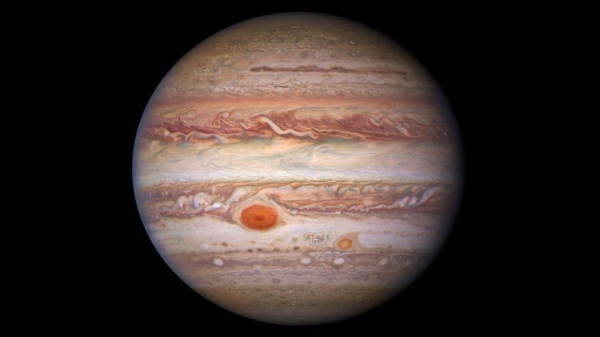
WASHINGTON — Jupiter already reigns as king of the planets — it’s the largest one in our solar system. And now, the gas giant has the most known moons, too.
Astronomers have observed 12 additional moons orbiting Jupiter, bringing its total number of confirmed moons to 92.
The discovery was made during observations by astronomer Scott Sheppard of the Carnegie Institution for Science and his team. They used the Subaru Telescope in Hawaii in September 2021 and the Dark Energy Camera located on the Blanco telescope at the Cerro Tololo Inter-American Observatory in Chile in August 2022. The Dark Energy Camera can survey the sky for faint objects.
Jupiter and its natural satellites were in alignment with more distant targets that Sheppard and his team have been seeking in the Kuiper Belt, a ring of icy objects circling the sun that’s located past the orbit of Neptune on the edge of the solar system.
“We have been surveying for new moons around Jupiter serendipitously while our main survey is looking for planets in the outer solar system beyond Pluto,” Sheppard said.
The team could tell the difference between Jupiter and the objects around it versus the distant solar system objects because any objects around Jupiter would be moving at the same rate as the gas giant. Distant solar system objects can’t move as quickly as objects moving with Jupiter.
Follow-up observations for the 12 new moons took about a year to confirm, and the team used the Magellan Telescope in Chile to conduct that work.
None of the moons have names yet since their discovery was just announced, but the Minor Planet Center will assign each one a number in the coming months.
The Minor Planet Center tracks the positions of minor planets, comets and space rocks. Under the auspices of the International Astronomical Union, the organization is responsible for the identification, designation and orbital data for such celestial objects.
“The International Astronomical Union allows the naming of any moon larger than about 1.5 miles (2.4 kilometers) in size, of which half of these new discoveries are larger than that, so they will get names,” Sheppard said.
Because Jupiter is a bright planet, astronomers have had to deal with the issue of glare and scattered light affecting the space where moons can exist.
Technology is making it easier to observe Jupiter and the area around it in greater detail.
Sheppard and his team are in the process of tracking “many, many more moons around Jupiter,” but they need more observations to confirm and announce their discoveries.
Finding additional moons around Jupiter and determining their orbits could help identify targets for future missions. The European Space Agency’s Jupiter Icy Moons Explorer, launching in April, and NASA’s Europa Clipper mission, expected to launch in 2024, will be visiting Jupiter and some of its moons this decade. And the missions might be able to swing by the newly discovered moons on their way.
“These outer moons can only be visited by these spacecraft as they enter Jupiter’s gravitational sphere of influence,” Sheppard said.
“The hope is that if we find enough, one of them will happen to just be near the spacecraft’s trajectory for it to get close-up images. These outer moons are important to understand because they are the last remnants of the population of objects that formed in the giant planet region as the rest of the material was incorporating into the planets.”
The giant planet region is where the largest planets in our solar system can be found, and it’s devoid of objects now because the planets gobbled up all of the material in the formation process.
Sheppard and his team believe that these moons are remnants of at least seven larger moons that broke apart when they collided with other moons, asteroids or comets. The fracturing of these moons led to the creation of hundreds of smaller moons, Sheppard said.
The moons are remnants of what was born in the disk of gas and dust around Jupiter after the planet formed and then captured and pulled most of the material into Jupiter’s orbit. These building blocks of planets can provide a window into the early years of the solar system.
Sheppard’s team has a knack for finding moons around the giant planets in our solar system.
“In total, we have been part of 70 moon discoveries around Jupiter,” he said via email. “For the other planets, it’s 43 discoveries at Saturn, 2 at Uranus and 1 at Neptune.”
Saturn has 83 moons, Uranus has 27, and Neptune has 14.
The team is also tracking many additional moons around Saturn, but they’re harder to locate because the ringed planet is farther from Earth.
“We believe both Uranus and Neptune also have a large number of small moons, but those planets are even more distant, so it is even harder to detect the smaller moons around those planets,” Sheppard said. — CNN












